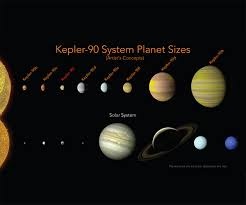NASA’s Kepler telescope discovers a solar system with eight planets
15 Dec 2017
US space agency National Aeronautics and Space Administration (NASA) on Thursday announced the discovery of an eighth planet orbiting the star Kepler-90, which makes the explanatory system almost like our own solar system and breaking the record for the star with the most exoplanets.
 The discovery was made by applying artificial intelligence to data from NASA's Kepler Space Telescope.
The discovery was made by applying artificial intelligence to data from NASA's Kepler Space Telescope.
NASA announced the discovery at a briefing on Thursday and in a paper due to be published in the Astronomical Journal the planet Kepler-90i demonstrates for the first time that other stars can host planetary systems as populous as our own solar system, the Los Angeles Times reported.
The findings also establish the growing role that neural networks and other machine learning techniques could play in the hunt for more elusive planets outside our own solar neighbourhood.
"Kepler has already shown us that most stars have planets," said Paul Hertz, director of NASA's Astrophysics Division in Washington. "Today, Kepler confirms that stars can have large families of planets just like our solar system."
All of the planets except for 90i were previously known. That put the Kepler-90 system in a tie with the seven-planet Trappist-1 system for the honour of most populous known exoplanet solar system.
In some ways, the Kepler-90 system seems to echo our own, with small rocky planets (Mercury, Venus, Earth, Mars) closer in to the sun and larger, more gas-rich ones (Jupiter and Saturn, Neptune and Uranus) lying farther out.
Scientists think there is a reason the larger planets orbit farther from their sun: It's the cool place to be.
"In our own solar system, this pattern is often seen as evidence that the outer planets formed in a cooler part of the solar system, where ice can stay solid and clumped together to make bigger and bigger planets," said Andrew Vanderburg, an astronomer at the University of Texas at Austin and one of the authors of the forthcoming study.
The same phenomenon could be at work here, scientists said.
The researchers said they aren't sure why the Kepler-90 system has such a crowded field. It could mean that at least some of the planets formed farther out and were eventually drawn inward.
Regardless, it means that Kepler 90i, third rock though it may be, is too hot to be habitable.
"Kepler-90i is not a place I'd like to go visit," Vanderburg said, adding that the planet probably has an average temperature of about 800 degrees Fahrenheit (426 degrees Celsius).
But that isn't where its similarities to our own solar system end. The next three planets beyond Kepler-90i's orbit (90d, 90e and 90f) fall into a sub-Neptune size class and orbit every 60, 92 and 125 days, respectively. The last two planets, 90g and 90h, are Jupiter-class gas giants, and take 211 and 332 days, respectively, to make a round trip.
All of the planets except for 90i were previously known. That put the Kepler-90 system in a tie with the seven-planet Trappist-1 system for the honour of most populous known exoplanet solar system.
In some ways, the Kepler-90 system seems to echo our own, with small rocky planets (Mercury, Venus, Earth, Mars) closer in to the sun and larger, more gas-rich ones (Jupiter and Saturn, Neptune and Uranus) lying farther out.
Regardless, Kepler 90i, third rock though it may be, is too hot to be habitable.
"Kepler-90i is not a place I'd like to go visit," Vanderburg said, adding that the planet probably has an average temperature of about 800 degrees Fahrenheit (426 degrees Celsius).
Our Milky Way galaxy is full of hundreds of billions of worlds just waiting to be found. In 2014, scientists using data from our planet-hunting Kepler space telescope discovered seven planets orbiting Kepler-90, a Sun-like star located 2,500 light-years away. Now, an eighth planet has been identified in this planetary system, making it tied with our own solar system in having the highest number of known planets.
Most planets beyond our solar system are too far away to be imaged directly. The Kepler space telescope searches for these exoplanets -those planets orbiting stars beyond our solar system - by measuring how the brightness of a star changes when a planet transits, or crosses in front of its disk. Generally speaking, for a given star, the greater the dip in brightness, the bigger the planet!
Researchers trained a computer to learn how to identify the faint signal of transiting exoplanets in Kepler's vast archive of deep-space data.
A search for new worlds around 670 known multiple-planet systems using this machine-learning technique yielded not one, but two discoveries: Kepler-90i and Kepler-80g. The latter is part of a six-planet star system located 1,000 light-years away.
Kepler-90 is the first known star system besides our own that has eight planets, but scientists say it won't be the last. Other planets may lurk around stars surveyed by Kepler. Next, researchers are using machine learning with sophisticated computer algorithms to search for more planets around 150,000 stars in the Kepler database.
Kepler is the most successful planet-hunting spacecraft to date, with more than 2,500 confirmed exoplanets and many more awaiting verification.






























